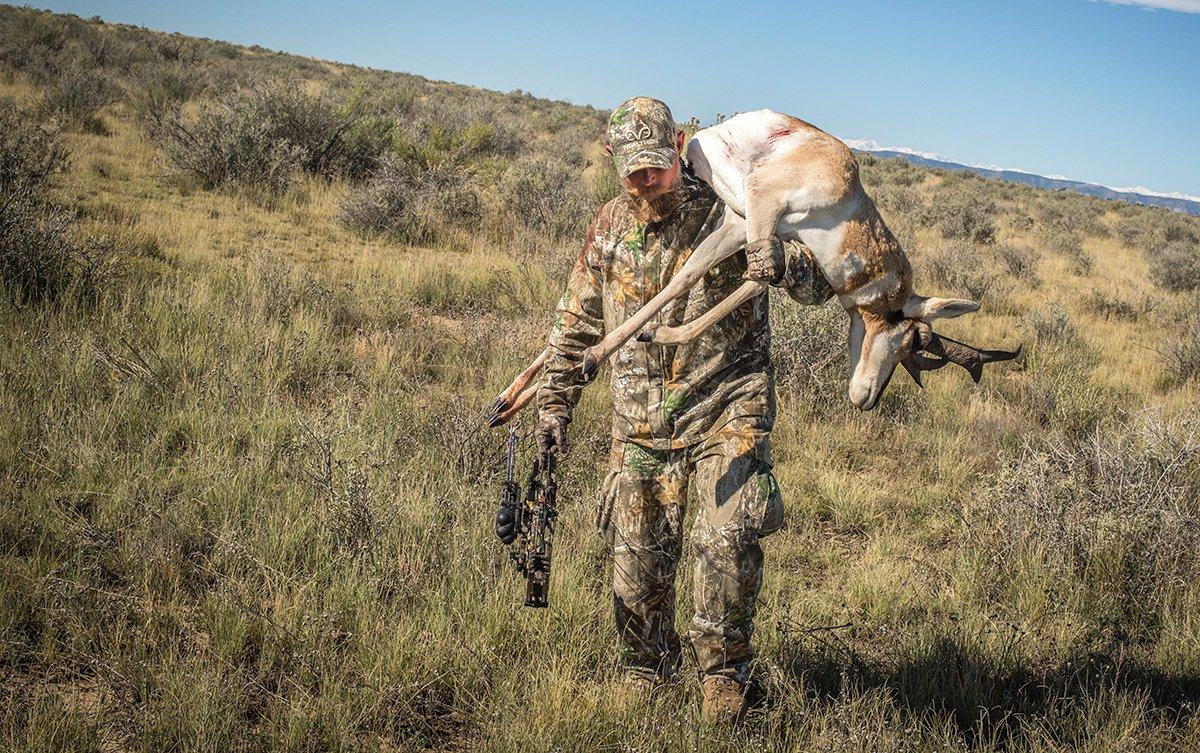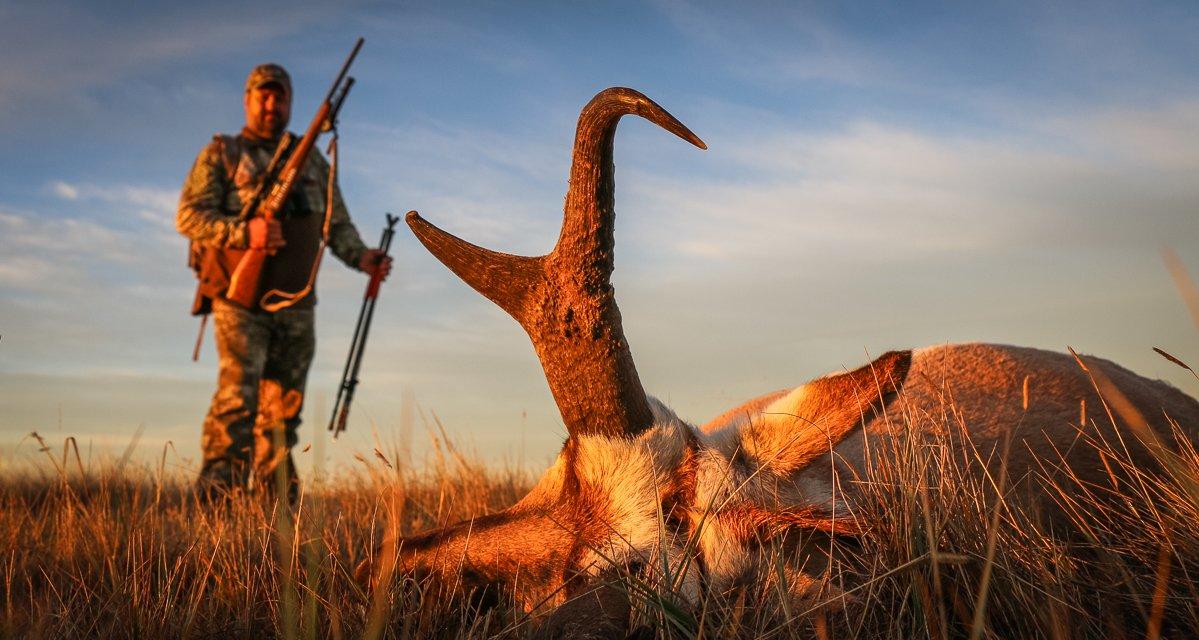Pronghorns are the gateway species for Western big-game hunters, and there's a long season full of opportunity. Here's when to go
I wouldn't go so far as to say a dead antelope buck smells good, but I don't mind their odor a bit. There's a hint of petting zoo goat — not necessarily repulsive in itself — mixed with dry Western air and sage and musk. All combined, somehow, the smell is sweet, and for me it always triggers good memories of hunting adventures far from home.
Just about every Easterner ever to buy a deer tag has at some point dreamed of hunting out West. I talk to eager prospects every year, and many of them want to come out swinging, with designs on an elk hunt in the mountains.
I love elk hunting, especially in September. But I always temper any encouragement I give with this reality: If you're not going guided, you're probably not going to kill an elk. Not your first year.
If you're prepared to pony up for a guided elk hunt, go for it. But for the price of even a cheap elk hunt, you can book two top-end antelope hunts. And if you have the gumption for a DIY trip, success comes much easier on a pronghorn hunt. We can talk about experiences and beautiful sunrises and all that … but I've always found the trip home to be better with a cooler of meat in tow.
First Western hunt or not, a pronghorn is a critter that I can't praise enough. They're abundant and accessible. Their behavior is fascinating, and the country where they live is plenty wild — but also not likely to kill you. Their reputation as table fare is mixed, but there's no call for that. I've never had one that wasn't fine eating. Just don't expect the bland flavor of corn-fed whitetail.
My buddy Miles Fedinec, who's been a Colorado guide and outfitter his entire adult life, agrees. He's an antelope nut, having guided a few clients to some of the state's all-time largest bucks. Antelope are the most underrated, overlooked opportunity we have, he says. You can come out here, see the West, hunt when the weather is nice, and in all likelihood, go home with a trophy animal that's great to eat. What's not to love about that?
I love it so much that I'm headed to Colorado again this fall, on my seventh pronghorn hunt. I've chased them on public land and private, all over Colorado and Wyoming, with bows, crossbows, muzzleloaders, and centerfire rifles. I've had a ball at it every single time, and have always gotten a buck, too.
Antelope season has phases just like any other season. I've hunted them all, but what you're after from the experience dictates the timing of your hunt. If you're looking at a calendar, here's what to know.
Early Archery
Mid-August to Early September
Pros: With the right conditions and a good setup, bowhunters can expect to see numerous animals, with high-odds shot opportunities.
Cons: You can't control the weather. An early cool snap or rainy spell can turn this into a PAINFULLY SLOW HUNT.

Archery seasons typically open mid-August (Aug. 15 in both Colorado and Wyoming), and the most productive way to hunt antelope at the time is from a ground blind over a water hole. Outfitters will have scouted options and set blinds ahead of time. If you're hunting on your own, plan to spend a couple of days on the front end, scouting water sources with optics and trail cameras, to figure out where to place your hide. Good thing is, pop-up ground blinds don't seem to bother the animals much.
Go early, because the hotter and drier the weather, the better the action will be. Bring a small cooler with lunch and plenty of drinks, a full charge on your phone, and more than a couple of good books. I once read the biography of an undercover agent who infiltrated an outlaw biker gang, cover to cover, in an antelope blind. I'd no more than closed it when I looked up and saw a buck coming.
If the conditions are good, you can expect to see plenty of animals, and to get a close-range shot. The action typically is at its best midmorning, but I've seen antelope walk in for a drink at all hours of the day. This style of hunting isn't especially difficult, but it is effective, and a whole lot of fun if the conditions are favorable. If getting an antelope with a bow is your main goal, try to plan your hunt before Sept. 1. Much later than that, and you run a risk of cool Western mornings and autumn rains spoiling the action.
The Rut
Mid-September to Early October
Pros: This is the rut, and it's action packed. It's also overlooked, since everyone else is elk hunting at the time.
Cons: It's tougher to fill a tag now with archery gear, since water-hole hunting is typically less productive and movement is less predictable.
As much fun as hunting over a water hole can be, the rut is my favorite time to hunt antelope. Antelope are aggressive critters that fight and chase all over creation when love is in the air. Hunting from a blind can still work. It doesn't hurt to have a water hole close by, but a fence gap between two pastures can really help seal the deal. One of the West's great mysteries is that antelope hate jumping fences, even though they're perfectly capable. I've watched them pace back and forth, for an hour and a mile, alongside a woven-wire fence. But a slight gap in the fence that they can squeeze through or under creates the equivalent of a whitetail hunter's perfect pinch point.
You can come out here, see the West, hunt when the weather is nice, and in all likelihood, go home with a trophy animal that's great to eat. What's not to love about that?
— Miles Fedinec
One morning a few years ago in Wyoming, I was in a blind 25 yards from just such a gap, waiting with a crossbow. I had a little buck on my side of the fence that had been farting around most of the morning. On the other side, well over a mile away, I could see a loose herd with a couple of good bucks chasing does, beating the snot out of each other, and generally acting like amorous antelope. I watched them for hours until finally, one of the bucks broke and began heading my way, presumably to find something else to chase or fight.
I could tell he was headed toward the fence gap. The little buck in front of me saw him, too, and stood at full alert. The big buck noticed him and set into a trot, and then a gallop, at that fence gap to run the little buck off. I shot him just as he slowed to cross the wire.
You can have a lot of fun by spot-and-stalk and decoy hunting this time of year, too. Keep eyes on doe groups with a good buck tending them. Don't get discouraged if he runs off after a doe or smaller buck, because he will come back. Use dips in terrain to work in as close as you dare. If you're archery hunting, try showing him a decoy, most of which are made to look like subordinate bucks. It's a lot like reaping a gobbler behind a fan, and if it happens, it usually happens fast.
Late Season
Mid-October to the End
Pros: Rifle seasons are typically open, and bucks are sometimes gathered in bachelor groups.
Cons: A late-season antelope that's been hunted a bit may be the country's spookiest critter.

Though there are some earlier opportunities, if you book a rifle hunt, odds are it'll happen in early October. The rut's waning by this point in the season, and animals are beginning to gather in larger herds, where they'll remain through the winter. Still, it's common to see a dominant buck with a large harem of does, especially early in the month. By midmonth, you're liable to see all sorts of combos, but bachelor groups of bucks start hanging around together, too.
I had a heck of a good time last year in late October in northeast Wyoming, where the bucks were grouped up. It was spitting snow and cold at daybreak, but it warmed up by midmorning, when we got on a group of about a dozen bucks, including two solid shooters. After two failed stalks, we finally crawled up to within 80 yards of them early that afternoon, for an easy shot.
Many people think of rifle hunting antelope as a long-range game, and if that's your thing, the chance is there. But a careful stalk through pretty country is the fun part of it. If you have hills to work with and a little patience, it's easy enough to slip to within 200 yards of them. A blown stalk doesn't always mean the end of the hunt, either. Give the animals time to settle down, and if you can locate them again, try them.
TOP STOPS
So where should you go? There are antelope all over the West (as far east as western Nebraska), but you can't go wrong with these tried-and-true destinations.
Wyoming It's often said that Wyoming has more pronghorns than people, and after multiple trips there, I don't doubt it. For pure opportunity, it's the place to be. Success rates statewide exceed 85%. Outfitters are numerous, or can try your hand at the draw system. There are 115 different hunting areas, and as you might expect, some areas are more difficult to draw than others. The north-central part of the state, near Gillette, is where I've hunted most. It has a crazy number of animals but more limited public access.
Colorado Archery hunters can buy over-the-counter tags and hunt many units in eastern Colorado. Public land is a little tough to come by there, but there are plenty of animals and outfitters available. It's wide open and flat, making spot-and-stalk hunting especially challenging. Northwest Colorado is better known as a trophy destination. It's hillier country, and an easier place to sneak in close. Getting a tag to hunt public land might take a few preference points, but it's worth the wait. Outfitters in the area frequently have landowner vouchers available for securing a license. You just have to book before they're all used up.
New MexicoThe world-record buck — a 96 4/8 monster shot by Mike Gallo in 2013 — was killed in Socorro County. New Mexico has a reputation for producing big critters, and antelope are no exception. Public draw hunts are available (apply in March), and outfitted hunts on private land are surprisingly affordable.










